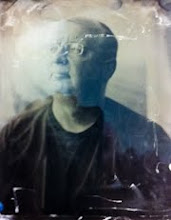Title: "Crown of Thorns"
(click image to view larger)
The topic of discussion at our house this morning was organic lemons, and their propensity for rapidly going moldy while stored at room temperature. Not such a large problem if one can buy a few at a time, but it seems that the local stores don't stock bulk organic lemons, just poly-bags of them. I suggested that when we buy a bag, we juice half the lemons and freeze it for use in recipes. Elena suggested that we also freeze the rinds for a ready source of lemon zest. Two great ideas! Elena then said that it was a pity no one knew we'd come up with these marvelous ideas (are you getting the impression we aren't modest?), and I responded that an idea is great even if only the person who came up with it knows about it. Greatness does not require an appreciative audience (even if it's natural that we'd welcome the recognition).
My friend JM Golding introduced me to the essays of W.R.D. Fairbairn on the psychology of art. I found the essays at our local university library, and was just now casually flipping the pages of his first essay, published in 1938, entitled "Prolegomena to a Psychology of Art". My eye fortuitously fell upon this passage: "Assuming that the shipwrecked Robinson Crusoe was an artist, it would be ridiculous to maintain that there was no art in the Juan Fernandez island until the arrival of the man Friday. Whereas art is unthinkable in the absence of either the artist or the work of art, there is at least no theoretical difficulty in conceiving of art in the absence of an audience."
This statement is most likely taken out of context of what Fairbairn is constructing (I have not read the entire article), but I like the fundamental concept the statement addresses. It speaks to the fact that art making is really a private, personal endeavor. Thet resulting art has an inherent quality that cannot be altered by the opinions or response of an audience. I think artists strongly connected to their work do not consider a positive response a "validation" of the work. Of course it's a pleasure to get positive feedback on something you are so invested in, but seeking validation from external sources to me suggests that there is less commitment to the work and too much thought of "pleasing" an audience. I don't have Frank Gohlke's book "Thoughts on Landscape" to hand at the moment, but I recall reading an interview that was conducted in front of a group of art students. There was a discussion about the reaction of a West Coast artist who visited New York, but found the art in galleries to be less engaging because of a perceived lack of "soul" or more specifically personal commitment on the part of the artist. Apparently the students in the audience rejected this reaction of the West Coast artist, feeling that he or she failed to understand the cultural differences between east and west coasts. In particular, the students rejected the idea that art could be made for personal reasons, and that those reasons enrich the experience for both artist and viewer. Gohlke reacted very strongly against this attitude of the students. As for Fairbairn, I'm curious to read what role he attributes to the audience.


1 comment:
I love the way you've used focus in this image to create both softness and prickliness.
I liked that part of the Fairbairn paper too :-)
Post a Comment